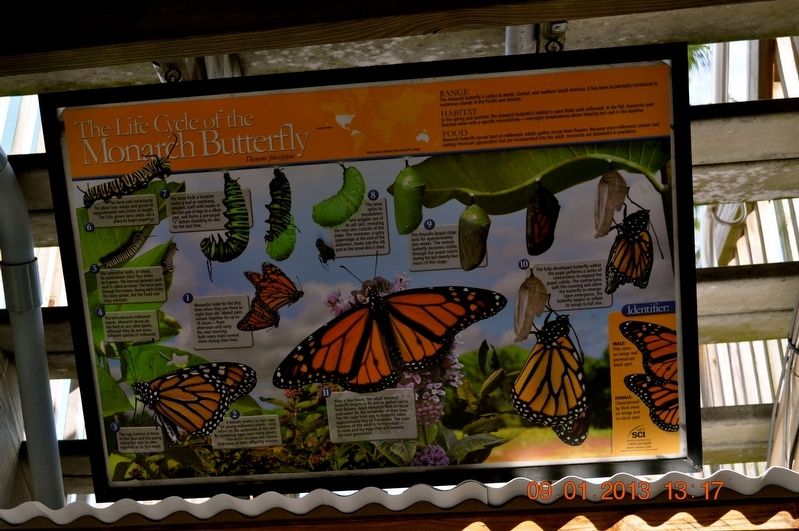Apollo Beach in Hillsborough County, Florida — The American South (South Atlantic)
The Life Cycle of the Monarch Butterfly
Dananus plexippus
Range
The monarch butterfly is native to North, Central, and northern South America. It has been accidentally introduced to numerous islands in the Pacific and Atlantic.
Habitat
In the spring and summer, the monarch butterfly’s habitat is open fields with milkweed. In the fall, monarch seek forested areas with a specific microclimate-overnight temperatures above freezing but cool in the daytime.
Food
Monarch butterfly larva feed on milkweed. Adult gather nectar from flowers. Because most milkweeds contain bad tasting chemicals (glycosides) that are incorporated into the adult, monarchs are distasteful to predators.
Monarchs mate for the first time when they are three to eight days old. Mated pairs remain together for up to 16 hours-from afternoon until early the next morning. Both sexes mate several times during their lives.
A female prefers to lay eggs on young milkweed plants, most often on the underside of the leaf. By scattering eggs over many plants, monarchs increase the chance that some of their offspring survive.
The egg hatches in three to four days and the young caterpillar eats its own eggshell as its first meal.
The larva devours milkweed leaves. Monarch larva do not feed on any other plants, although they do eat many different species of milkweed.
The caterpillar molts, or sheds, its exoskeleton (skin)four times as it grows. The interval between each molt is called instars. The larva goes through five instars.
During each instar the body grows, but the head size stays constant.
The larva eats voraciously for about two weeks and grows to approximately two inches in length. The fully grown larva seeks out a place to begin pupation.
The larva finds a location under a leaf or overhang, attaches itself with hooks in the last pair of legs to a silken pad, and forms a pre-pupal “j” before shedding its skin for the last time.
The larva splits its exoskeleton and wiggles out of its old skin, revealing the new skin (cuticle) of the pupa. The cremaster, a spiny appendage at the end of the abdomen, hooks into the silk pad as the larva skin is shed.
The chrysalis (pupa) stage lasts for approximately two weeks. The mature butterfly becomes visible through the pupal cuticle during the last twenty-four hours of this stage.
The fully developed butterfly within the pupa performs a series of contractions to expand the pupal cuticle. The contractions split the covering and allow the butterfly to emerge. Upon emergence, the butterfly begins to inflate its wings to a full size.
After a few hours, the adult monarch butterfly begins to fly and to gather nectar from flowers. Adult monarchs feed on nectar and water for the remainder of their lives. The life cycle from egg to butterfly takes approximately four to five weeks. The main function of the adult is to reproduce — to mate and lay eggs that will become the next generation.
Identifier:
Male: Thin veins on wings and pronounced black spot.
Female: Characterized by thick veins on wings and no black spots.
NEO
SCI
1-800-526-6689
www.neosci.com
Topics. This historical marker is listed in these topic lists: Animals • Environment.
Location. 27° 47.557′ N, 82° 24.074′ W. Marker is in Apollo Beach, Florida, in Hillsborough County. Marker is on Dickman Rd. Marker is located inside park. Touch for map. Marker is at or near this postal address: 6690 Dickman Rd, Apollo Beach FL 33572, United States of America. Touch for directions.
Other nearby markers. At least 8 other markers are within 6 miles of this marker, measured as the crow flies. Storm Water and the Estuary (here, next to this marker); Manatee Scar Identification (here, next to this marker); What Role Do Mangroves Play In An Estuary? (here, next to this marker); Long-Legged Wading Birds Stalk the Shallows (here, next to this marker); Listen carefully to hear a manatee! (approx. 0.2 miles away); Do You See a Manatee? (approx. 0.2 miles away); A Butterfly’s Habitat (approx. ¼ mile away); Staking Their Claim (approx. 5.4 miles away). Touch for a list and map of all markers in Apollo Beach.
Also see . . .
1. Butterflies Life Cycle. Let’s explore a butterfly’s life cycle in detail, including all four stages of life. All butterflies have "complete metamorphosis." To grow into an adult they go through 4 stages: egg, larva, pupa and adult. Each stage has a different goal - for instance, caterpillars need to eat a lot, and adults need to reproduce. Depending on the type of butterfly, the life cycle of a butterfly may take anywhere from one month to a whole year. You can print out this Butterfly Life Cycle coloring page to follow along as we talk about the 4 stages. (Submitted on August 3, 2017, by Sandra Hughes Tidwell of Killen, Alabama, USA.)
2. The Lifecycle of a Butterfly. Butterflies go through a life cycle. A butterfly has four stages in its life cycle. Each stage is different. Each stage also has a different goal. A butterfly becoming an adult is called metamorphosis. The life cycle process can take a month to year. It depends on the type of butterfly. (Submitted on August 3, 2017, by Sandra Hughes Tidwell of Killen, Alabama, USA.)
Credits. This page was last revised on August 7, 2017. It was originally submitted on August 3, 2017, by Sandra Hughes Tidwell of Killen, Alabama, USA. This page has been viewed 234 times since then and 14 times this year. Photo 1. submitted on August 3, 2017, by Sandra Hughes Tidwell of Killen, Alabama, USA. • Bill Pfingsten was the editor who published this page.
